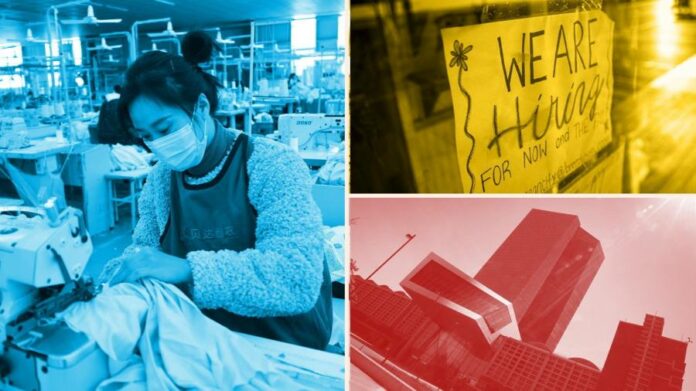Did US jobs growth slow in November?
Economists expect the US economy continued adding jobs in November despite rising interest rates and concerns of a looming recession.
Wall Street expects the number of people on US payrolls rose by 200,000 in November from the previous month, according to economists polled by Reuters. This would be the lowest job creation since December 2020 and down from the 261,000 jobs added in October. However, the robust employment gains would show strength in an already tight labour market that is in contrast with other sectors of the economy, such as the housing market or retail sales, which are struggling under the aggressive pace of interest rate increases, according to Sandra Horsfield, economist at Investec.
US job creation has come in stronger than expected for the last seven months, bolstering the case for the Federal Reserve’s decision to raise its policy rates by historically large 0.75 percentage points in the last four meetings as it battles with high inflation. “The Fed will be hoping for some loosening in labour market conditions in next week’s report to justify a smaller increment policy rate hike at its next meeting in December, as is widely expected,” said Horsfield.
Kevin Cummins, chief economist at NatWest said that many firms have signalled they may need to reassess their hiring needs, but “so far at least, there still appears to be enough of a backlog at other firms helping keep job growth strong heading into year end”. He, however, expects US job gains will slow in 2023 as the economy is likely to tip into a recession that he forecasts will last through the first half of next year. Valentina Romei
How is China’s factory sector faring?
Conflicting currents buffeted the Chinese economy in November, muddying the picture as to the strength of the country’s vast factory sector. The Caixin-Markit manufacturing purchasing managers’ index should provide clues.
On-off signalling from the government that it would ease some tenets of its strict zero-Covid policy were set against record daily virus caseloads and renewed lockdowns. Meanwhile, China’s state banks extended a series of mammoth credit lines to the country’s property sector — an important driver of manufacturing activity — as global trade and demand for Chinese goods showed signs of slowing.
Analysts at Barclays predict a reading of 49 for the Caixin PMI data, below the 50-point threshold that separates contraction from expansion, and an acceleration to the downturn signalled by last month’s reading of 49.2. Consensus estimates for the country’s official manufacturing PMI, which places greater emphasis on larger, state-owned companies than the Caixin one, also forecast a reading of 48.9.
While analysts say slowing global trade will hit manufacturers from Taiwan to South Korea this month, in China there are the added complications of life under zero-Covid. And while the property credit lines and limited Covid easing may have boosted market sentiment, manufacturers are likely to still feel the pinch.
“Both official manufacturing and non-manufacturing PMIs for China should be in deeper contraction . . . as the number of Covid cases increased, affecting both factory and retail activities,” wrote analysts at ING, the Dutch bank. “This should also be reflected in the Caixin manufacturing PMI numbers which could show a bigger contraction, as smaller factories are more adversely affected given the challenging logistical situation.” William Langley
Will eurozone inflation fall?
Inflation has been rising in the eurozone for 16 consecutive months, yet economists expect this trend to have been broken in November. If they are right it may be enough to convince the European Central Bank to reduce the size of interest rate rises at its meeting next month.
The harmonised index of consumer prices for the 19-country single currency bloc is expected to rise 10.4 per cent in the year to November, according to a Reuters poll of economists.
While still painfully high, this would mark an important change of direction, dipping from the eurozone’s all-time record inflation of 10.6 per cent in October. Economists expect the fall to have been caused by the “base effect” of a drop in energy prices from the year-ago period.
“Energy prices were probably the only source of downward pressure on inflation, mainly due to a base effect,” said Marco Valli, chief economist at UniCredit.
Carsten Brzeski, head of macro research at ING, said eurozone inflation “could indeed slightly drop” but he added: “It is still extremely complicated to measure the timing of the pass-through of market gas prices into consumer price inflation.”
ECB rate-setters will be watching core inflation, excluding volatile energy and food prices, just as closely as the headline number. Valli said the core number was likely to flatline at 5 per cent, which may not be enough for the ECB to pivot down from its recent 0.75 percentage point rate rises. Martin Arnold






